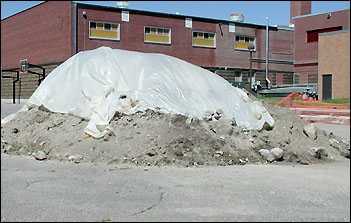Tank leak responsible for contaminated soil at PAES
All the soil from around the tank was removed so a new tank could be installed, but the school district is still waiting to hear from the Minnesota Pollution Control Agency (MPCA) the extent of the monitoring that will be required.
 The Paynesville Area School District received a grant from the state for $46,000 to remove the old tank and replace it with a new 6,000-gallon fiberglass tank with double walls and leak detection. Because it was the last time the grant would be available, the district decided to replace the old tank with a better tank.
The Paynesville Area School District received a grant from the state for $46,000 to remove the old tank and replace it with a new 6,000-gallon fiberglass tank with double walls and leak detection. Because it was the last time the grant would be available, the district decided to replace the old tank with a better tank.
The contaminated dirt that once surrounded a 12,000-gallon fuel tank at the Paynesville Area Elementary School is expected to be removed in the next two weeks, before school starts.
In mid-June, the 12,000-gallon steel tank was removed from the south parking lot behind the elementary school. The holes found in it were beleived to be caused only by old age. The date that the tank was installed in the school is unknown as no records were kept of it, said Donnie Mayer, building and grounds supervisor.
After they found that the tank had leaked, dirt samples were taken by the MPCA, which determined the dirt to be contaminated.
The pile of contaminated dirt remains in the parking lot of PAES. The disposal of the soil will cost approximately $3,000, according to Mayer. The dirt is expected to be gone in the next two weeks, he added, before school starts.
After all of the paperwork is complete, a long process according to Mayer, the next step will be for the MPCA to do a "limited sight investigation." This is a process where they drill test holes around the contaminated area to find the area and distance the fuel traveled through the soil. This process will cost around $5,000, he said.
Once they find the area affected, Mayer said, they will install monitoring stations and conduct quarterly testing of the area until it clears up. It usually clears up by itself, he added, but they have to keep monitoring to make sure it doesn't spread.
Mayer said that the leak does not pose any threat to drinking water in or around the schools. The monitoring is just to make sure the pollution doesn't get to any lakes or wells, he said.
Because the number of holes to be drilled and time spent monitoring is unknown, the total cost of the project will not be known until these details are finalized.
The school will have to pay for all of the costs for removal of soil, drilling, and monitoring. However, at the end of the cleanup process, the district will be reimbursed for 90 percent of their costs by the Petroleum Tank Release Cleanup Fund (Petrofund).
This state reimbursement comes only after all contamination and problems are cleared and could take months or possibly years.
Contact the author at editor@paynesvillepress.com • Return to News Menu
Home | Marketplace | Community